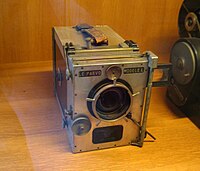André Debrie
André Victor Léon Clément Debrie (born January 28, 1891 ; † May 28, 1967 ) was the founder of the André Debrie Establishment . The business came from his father Joseph Jules Debrie . In 1898 it was entered in the commercial register and its registered office was on Rue Saint-Maur in Paris.
One of the first Debrie products was a film perforator. The first model from 1898 was replaced by OPTIMA about ten years later. In 1905 Debrie offered a NOVA film copier, a table-top device with a similarly simple structure as other products.
The parvo
The English cameraman Charles Raleigh asked father Debrie in 1906 if he could build a lightweight film camera for a safari. JJ Debrie commissioned André with a construction that was to combine all the advantages of time. In the spring of 1907, Norman O. Dawn bought one of the first models, with which he traveled to California in April 1907. In 1908 the Parvo ("squat") came out as a series product with a few new ideas, the professional camera in Europe for many years. In 1921, locking pins were added to it as one of the improvements, keeping the image stand up to date with the later Mitchell Newsreel Camera . There is space for 400 feet (122 m) of normal film in the parvo . The camera operator can use a finder tube to focus on the film from behind, and on the later models also on a swiveling screen. The camera was only available with a wooden housing, and from 1920 with an aluminum housing, the models Interview, E, K, L and T. In total, more than 6000 Parvo were sold.
The Super Parvo
The self- blued Debrie Super Parvo was developed from 1932 and came out in 1933. The patent was filed in November 1934 and granted on June 2, 1936. Due to its successful construction, it quickly advanced to become the standard European studio camera of the 1930s, 1940s and 1950s. She was in u. A. France, Sweden , England, Germany, and Austria used. Its dimensions of 50 × 27 × 35 cm and a weight of 65 kilograms were quite acceptable for a sound film camera at the time. It had a magazine integrated into the camera for 300 m of film and coaxial film, there was a synchronous motor for luminous flux and a 24 volt motor as a drive. The cameraman only saw the image through the film, which was not a problem with black and white film, but with color film, due to the opaque back, no view through was possible. There was a side viewfinder that could be attached, but it was not parallax-free and the filmed image was not 100% reproduced. The handling of the Super Parvo was therefore considered a bit complicated, but other cameras like the famous Mitchell BNC worked on the same principle. Over time, the camera's running noise had to be dampened with blankets tied around the camera due to the increasingly sensitive microphones. At the beginning of the 1940s - spurred on by the success of the Arriflex and the emerging color film - André Debrie also developed a reflex viewfinder for his Super Parvo. The patents were registered in November 1941, but the Super Parvo Reflex Model 5 was not presented to the public until 1951 at the Photokina in Cologne. This was slightly larger than the old model (67 × 32 × 38 cm) and weighed an impressive 82 kilograms, and it was 50% quieter than its predecessor. Older models could also be converted. The highlight of the 1950s was the Super Parvo Color , a Super Parvo Reflex with an objective nosepiece for interchangeable lenses, which was specially developed for color film. This was also very successful and was used until the 1970s. Debrie Cooke lenses supplied for most of the Parvos, while Dyaliscope in France also offered their scope lenses for the Super Parvos.

More products from Debrie
In 1919 the Ciné-Sept, invented by Giuseppe Tartara and for which Debrie bought the patent, appeared, a popular small device for normal film with moving locking pins, built by Victor Continsouza .
One of the most popular copier machines was the Debrie MATIPO, which came out in 1913.
From 1923 Debrie also built the G rande V itesse camera designed by Émile Georges Labrély (1885–1971) . Image frequencies of up to 240 are possible with it. The device has locking pins that engage to the left and right of the image window. French patent 521.417 of October 4, 1919: "Dispositif permettant de photographier ou de cinématographier des sujets quelconques pendant leurs déplacements les plus rapides en tous sens." French patent 523,383 of August 31, 1920: "Perfectionnements apportés aux prises de vues cinématographiques à grande vitesse."
André Debrie gradually supplied all kinds of developing machines, film planers, glue presses, rewinders, narrow film projectors such as the MB 15, optical sound systems, the TRUCA trick copier and many more
André Debrie was the sole owner of the company from 1920 to 1963. In 1992 the Etablissements Debrie and CTM were merged, the mechanics department of the film technology company GTC, Société Générale de Travaux Cinématographiques, which became independent in 1951.
Web links
- Wolfgang Dittrich: Facts and fragments on the Freiburg film production history 1901–1918. freiburg-postkolonial.de, November 12, 2013, accessed on January 21, 2019 .
- Cinéma Tirage L. Maurice. Cinematographes, 2008, accessed on January 21, 2019 (French).
- Filmkameror ur SFI: s filmhistoriska samlingar. Retrieved July 17, 2019 .
Individual evidence
- ↑ 38 Super Parvo Color. October 4, 2017, accessed July 17, 2019 .
| personal data | |
|---|---|
| SURNAME | Debrie, André |
| ALTERNATIVE NAMES | Debrie, André Victor Léon Clément |
| BRIEF DESCRIPTION | Founder of the "Etablissements André Debrie" |
| DATE OF BIRTH | January 28, 1891 |
| DATE OF DEATH | May 28, 1967 |


